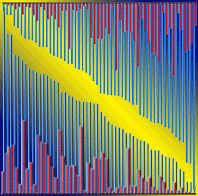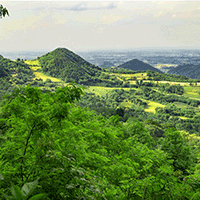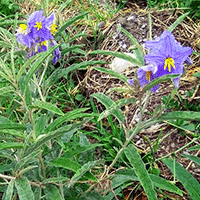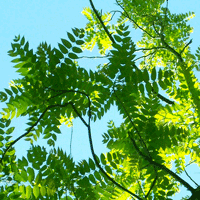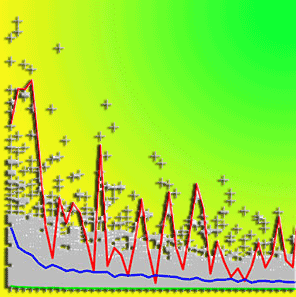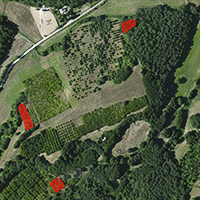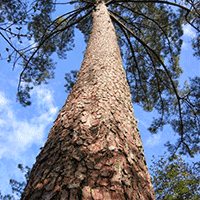There is a direct relationship between the abundance of biological invasions and their impact, which means that it is important to capture spatial patterns in their abundance and use this information to focus management actions. However, protocols to objectively determine invasive alien plant (IAP) distributions and abundance are lacking at a national level, resulting in the inability to determine and monitor changes in spatial extent and density over time. A complete inventory of IAP spatial distribution across an extensive area such as South Africa is not possible and so requires an efficient sampling approach. A simple random sampling design would not be efficient, so monitoring of IAP species at a national level requires an appropriate sampling design such as a stratified sampling. The selection of environmental variables to be included in such a stratification should be based on the relationship between IAP species and their physical environment to successfully summarize variance in their abundance within the different strata. A further objective is to obtain all possible combinations of environmental variables or a full rank design in the stratification to allow for the comparison of different strata based on actual field sampled data. This raises the question of which predictive environmental variables as well as how many to include in the stratification. For this purpose, three invasive tree species, namely Acacia cyclops, Acacia mearnsii and Prosopis glandulosa were selected as they cover the maximum possible area at the highest density with the least amount of geographic overlap. A total of 26 environmental variables that included climatic, soil and topographic type variables were tested with linear regressions against correlations with the abundance of those tree species. The results showed that a combination of average precipitation, soil depth, clay content in the B-horizon and terrain morphological units will serve as a suitable stratification at a national level to explain IAP abundance variation sufficiently well whilst retaining a full rank design. These results will be applied as the first phase in the formation of a regional level IAP monitoring programme for South Africa on a scientific basis.
Keywords
, , , ,
Citation
Kotze JDF, Beukes HB, Seifert T (2019). Essential environmental variables to include in a stratified sampling design for a national-level invasive alien tree survey. iForest 12: 418-426. - doi: 10.3832/ifor2767-012
Academic Editor
Francisco Lloret Maya
Paper history
Received: Feb 23, 2018
Accepted: Jun 12, 2019
First online: Sep 01, 2019
Publication Date: Oct 31, 2019
Publication Time: 2.70 months
© SISEF - The Italian Society of Silviculture and Forest Ecology 2019
Open Access
This article is distributed under the terms of the Creative Commons Attribution-Non Commercial 4.0 International (https://creativecommons.org/licenses/by-nc/4.0/), which permits unrestricted use, distribution, and reproduction in any medium, provided you give appropriate credit to the original author(s) and the source, provide a link to the Creative Commons license, and indicate if changes were made.

Breakdown by View Type
(Waiting for server response...)
Article Usage
Total Article Views: 46815
(from publication date up to now)
Breakdown by View Type
HTML Page Views: 39149
Abstract Page Views: 4154
PDF Downloads: 2753
Citation/Reference Downloads: 1
XML Downloads: 758
Web Metrics
Days since publication: 2297
Overall contacts: 46815
Avg. contacts per week: 142.67
Article Citations
Article citations are based on data periodically collected from the Clarivate Web of Science web site
(last update: Mar 2025)
Total number of cites (since 2019): 4
Average cites per year: 0.57
Publication Metrics
by Dimensions ©
Articles citing this article
List of the papers citing this article based on CrossRef Cited-by.
(1)
Aitor GJ, Garcia-Viñas JI (2011)Modelling species distributions with penalised logistic regressions: a comparison with maximum entropy models. Ecological Modelling 222 (13): 2037-2041.
CrossRef |
Gscholar
(2)
Anderson RP, Lew D, Peterson AT (2003)Evaluating models of species’ geographic distributions: criteria for selecting optimal models. Ecological Modeling 162: 211-232.
CrossRef |
Gscholar
(3)
Cronin D (2018)Handbook of soil fertility. Callisto Reference, New York, USA, pp. 240.
Gscholar
(4)
De Lange WJ, Van Wilgen BW (2010)An economic assessment of the contribution of biological control to the management of invasive alien plants and to the protection of ecosystem services in South Africa. Biological Invasions 12 (12): 4113-4124.
CrossRef |
Gscholar
(5)
Dehnen-Schmutz K, Boivin T, Essl F, Groom QJ, Harrison L, Touza JM, Bayliss H (2018)Alien futures: what is on the horizon for biological invasions? Diversity and Distributions 24: 1149-1157.
CrossRef |
Gscholar
(6)
Dormann CF (2011)Modelling species’ distributions. In: “Modelling Complex Ecological Dynamics: An Introduction Into Ecological Modelling for Students, Teachers and Scientists” (Jopp F, Reuter H, Breckling B eds). Springer, Berlin, Germany, pp. 3-22.
CrossRef |
Gscholar
(7)
Dormann CF, Elith J, Bacher S, Buchmann C, Carl G, Carré G, García Marquéz JR, Gruber B, Lafourcade B, Leitão PJ, Münkemüller T, Mcclean C, Osborne PE, Reineking B, Schröder B, Skidmore AK, Zurell D, Lautenbach S (2013)Collinearity: a review of methods to deal with it and a simulation study evaluating their performance. Ecography 35: 1-20.
CrossRef |
Gscholar
(8)
Driver A, Sink KJ, Nel JL, Holness S, Van Niekerk L, Daniels F, Jonas Z, Majiedt PA, Harris L, Maze K (2012)National Biodiversity Assessment 2011: an assessment of South Africa’s biodiversity and ecosystems. Synthesis Report. South African National Biodiversity Institute and Department of Environmental Affairs, Pretoria, South Africa, pp. 24.
Online |
Gscholar
(9)
Elith J, Franklin J (2017)Species distribution modeling. In: “Reference Module in Life Sciences”. Elsevier, Amsterdam, Netherlands, pp. 15.
Gscholar
(10)
ESRI (2017)ArcGIS Desktop Release 10.6. Environmental Systems Research Institute, Redlands, CA, USA.
Gscholar
(11)
Fahrmeir L, Kneib T, Lang S, Marx B (2013)Regression: models, methods and applications. Springer-Verlag, Heidelberg, Germany, pp. 698.
Online |
Gscholar
(12)
Farr TG, Rosen PA, Caro E, Crippen R, Duren R, Hensley S, Kobrick M, Paller M, Rodriguez E, Roth L, Seal D, Shaffer S, Shimada J, Umland J, Werner M, Oskin M, Burbank D, Alsdorf D (2007)The Shuttle Radar Topography mission. Reviews of Geophysics 45: 1-33.
CrossRef |
Gscholar
(13)
Fick SE, Hijmans RJ (2017)WorldClim 2: new 1-km spatial resolution climate surfaces for global land areas. International Journal of Climatology 37: 4302-4315.
CrossRef |
Gscholar
(14)
Fois M, Cuena-Lombraña A, Fenu G, Bacchetta G (2018)Using species distribution models at local scale to guide the search of poorly known species: review, methodological issues and future directions. Ecological Modelling 385: 124-132.
CrossRef |
Gscholar
(15)
Franklin J (2010)Mapping species distributions: spatial inference and prediction. Cambridge University Press, Cambridge, UK, pp. 340.
CrossRef |
Gscholar
(16)
Gitzen RA, Millspaugh JJ, Cooper AB, Licht DS (2012)Design and analysis of long-term ecological monitoring studies. Cambridge, Cambridge University Press, UK, pp. 560.
Online |
Gscholar
(17)
Hageer Y, Esperón-Rodríguez M, Baumgartner JB, Beaumont LJ (2017)Climate, soil or both? Which variables are better predictors of the distributions of Australian shrub species? PeerJ 5: e3446.
CrossRef |
Gscholar
(18)
Henderson L, Wilson JRU (2017)Changes in the composition and distribution of alien plants in South Africa: an update from the Southern African Plant Invaders Atlas. Bothalia 47 (2): 1-26.
CrossRef |
Gscholar
(19)
Jeschke JM, Bacher S, Blackburn TM, Dick JTA, Essl F, Evans T, Gaertner M, Hulme PE, Kühn I, Mrugala A, Pergl J, Pyšek P, Rabitsch W, Ricciardi A, Richardson DM, Sendek A, Vilà M, Winter M, Kumschick S (2014)Defining the impact of non-native species: resolving disparity through greater clarity. Conservation Biology 28: 1188-1194.
CrossRef |
Gscholar
(20)
Kalkhan MA (2011)Spatial statistics: geospatial information modelling and thematic mapping. CRC Press, Boca Raton, FL, USA, pp. 184.
CrossRef |
Gscholar
(21)
Keppel G (1982)Design and analysis: an experimenter’s handbook (4th edn). Pearson, CA, USA, pp. 611.
Gscholar
(22)
Kumschick S, Gaertner M, Vilà M, Essl F, Jeschke JM, Pyšek P, Ricciardi A, Bacher S, Blackburn TM, Dick JTA, Evans T, Hulme PE, Kühn I, Mrugala A, Pergl J, Rabitsch W, Richardson DM, Sendek A, Winter M (2015)Ecological impacts of alien species: quantification, scope, caveats and recommendations. BioScience 65: 55-63.
CrossRef |
Gscholar
(23)
Land Type Survey Staff (2006)Land types of South Africa: digital map (1:250 000 scale) and soil inventory databases. ARC - Institute for Soil, Climate and Water, Pretoria, South Africa.
Gscholar
(24)
Le Maitre DC, Forsyth GG, Dzikiti S, Gush MB (2016)Estimates of the impacts of invasive alien plants on water flows in South Africa. Water SA 42: 659-672.
CrossRef |
Gscholar
(25)
Lemke D, Brown JA (2012)Habitat modeling of alien plant species at varying levels of occupancy. Forests 3: 799-817.
CrossRef |
Gscholar
(26)
MathWorks (2017)MATLAB and Statistics toolbox release 2017a. The MathWorks, Inc., Natick, MA, USA.
Gscholar
(27)
Mittermeier RA, Turner WR, Larsen FW, Brooks TM, Gascon C (2011)Global biodiversity conservation: the critical role of hotspots. In: “Biodiversity Hotspots - Distribution and Protection of Conservation Priority Areas” (Zachos FE, Habel JC eds). Springer, Berlin, Germany, pp. 3-22.
CrossRef |
Gscholar
(28)
Naesset E, Gobakken T, Solberg S, Gregoire TG, Nelson R, Ståhl G, Weydahl D (2011)Model-assisted regional forest biomass estimation using LiDAR and InSAR as auxiliary data: a case study from a boreal forest area. Remote Sensing of Environment 115: 3599-3614.
CrossRef |
Gscholar
(29)
Nel JL, Richardson DM, Rouget M, Mgidi T, Mdzeke N, Le Maitre DC, Van Wilgen BW, Schonegevel L, Henderson L, Neser S (2004)A proposed classification of invasive plant species in South Africa: towards prioritizing species and areas for management action. South African Journal of Science 100: 53-64.
Online |
Gscholar
(30)
Peterman WE, Crawford JA, Kuhns AR (2013)Using species distribution and occupancy modeling to guide survey efforts and assess species status. Journal for Nature Conservation 21: 114-121.
CrossRef |
Gscholar
(31)
Ricciardi A, Blackburn TM, Carlton JT, Dick JTA, Hulme PE, Iacarella JC, Jeschke JM, Liebhold AM, Lockwood JL, MacIsaac HJ, Pyšek P, Richardson DM, Ruiz GM, Simberloff D, Sutherland WJ, Wardle DA, Aldridge DC (2017)Invasion science: a horizon scan of emerging challenges and opportunities. Trends in Ecology and Evolution 32: 464-474.
CrossRef |
Gscholar
(32)
Robinson AP, Walshe T, Burgman MA, Nunn M (2017)Invasive species: risk assessment and management. Cambridge University Press, Cambridge, UK, pp. 426.
Online |
Gscholar
(33)
Rouget M, Hui C, Renteria J, Richardson DM, Wilson JRU (2015)Plant invasions as a biogeographical assay: vegetation biomes constrain the distribution of invasive alien species assemblages. South African Journal of Botany 101: 24-31.
CrossRef |
Gscholar
(34)
Sahragard HP, Ajorloa M (2018)Comparison of logistic regression and maximum entropy for distribution modeling of range plant species (a case study in rangelands of western Taftan, southeastern Iran). Turkish Journal of Botany 42: 28-37.
Online |
Gscholar
(35)
Särndal C (2010)Models in survey sampling. Statistics in Transition 11 (3): 539-554.
Online |
Gscholar
(36)
Simberloff D, Genovesi P, Pyšek P, Campbell K (2011)Recognizing conservation success. Science 332: 419.
CrossRef |
Gscholar
(37)
Smith WB (2002)Forest inventory and analysis: a national inventory and monitoring program. Environmental Pollution 116: 233-242.
CrossRef |
Gscholar
(38)
Soti P, Jayachandran K, Koptur S, Volin JC (2015)Effect of soil pH on growth, nutrient uptake, and mycorrhizal colonization in exotic invasive Lygodium microphyllum. Plant Ecology 216 (7): 989-998.
CrossRef |
Gscholar
(39)
Ståhl G, Saarela S, Schnell S, Holm S, Breidenbach J, Healey SP, Patterson PL, Magnussen S, McRoberts RE, Gregoire TG (2016)Use of models in large-area forest surveys: comparing model-assisted, model-based and hybrid estimation. Forest Ecosystems 3: 5.
CrossRef |
Gscholar
(40)
Stockwell DRB (1999)Genetic algorithms II. In: “Machine learning methods for ecological applications” (Fielding AH ed). Kluwer, Dordrecht, Netherlands, pp. 123-144.
CrossRef |
Gscholar
(41)
Symonds MRE, Moussalli A (2011)A brief guide to model selection, multimodel inference and model averaging in behavioural ecology using Akaike’s information criterion. Behavioral Ecology and Sociobiology 65: 13-21.
CrossRef |
Gscholar
(42)
Van Wilgen BW, Forsyth GG, Le Maitre DC, Wannenburgh A, Kotze JDF, Van Den Berg E, Henderson L (2012)An assessment of the effectiveness of a large, national-scale invasive alien plant control strategy in South Africa. Biological Conservation 148: 28-38.
CrossRef |
Gscholar
(43)
Vilà M, Hulme PE (2017)Impact of biological invasions on ecosystem services. Springer-Verlag, Heidelberg, Germany, pp. 354.
Online |
Gscholar
(44)
Vinogradova Y, Pergl J, Essl F, Hejda M, Van Kleunen M, Pyšek P (2018)Invasive alien plants of Russia: insights from regional inventories. Biological Invasions 20: 1931-1943.
CrossRef |
Gscholar
(45)
Volis S (2016)Species-targeted plant conservation: time for conceptual integration. Israel Journal of Plant Sciences 63: 232-249.
CrossRef |
Gscholar
(46)
Wang O, Zachmann LJ, Sesnie SE, Olsson AD, Dickson BG (2014)An iterative and targeted sampling design informed by habitat suitability models for detecting focal plant species over extensive areas. PLoS One 9 (7): e101196.
CrossRef |
Gscholar
(47)
Webster R, Lark RM (2013)Field sampling for environmental science and management. Routledge, London, UK, pp. 192.
Gscholar
(48)
Williams KJ, Belbin L, Austin MP, Stein JL, Ferrier S (2012)Which environmental variables should I use in my biodiversity model? International Journal of Geographical Information Science 26: 2009-2047.
CrossRef |
Gscholar
(49)
Wilson JRU, Faulkner KT, Rahlao SJ, Richardson DM, Zengeya TA, Van Wilgen BW (2018)Indicators for monitoring biological invasions at a national level. Journal of Applied Ecology 55: 2612-2620.
CrossRef |
Gscholar
(50)
Xu H, Qiang S, Genovesi P, Ding H, Wu J, Meng L, Han Z, Miao J, Hu B, Guo J, Sun H, Huang C, Lei J, Le Z, Zhang X, He S, Wu Y, Zheng Z, Chen L, Jarošík V, Pyšek P (2012)An inventory of invasive alien species in China. NeoBiota 15: 1-26.
CrossRef |
Gscholar
